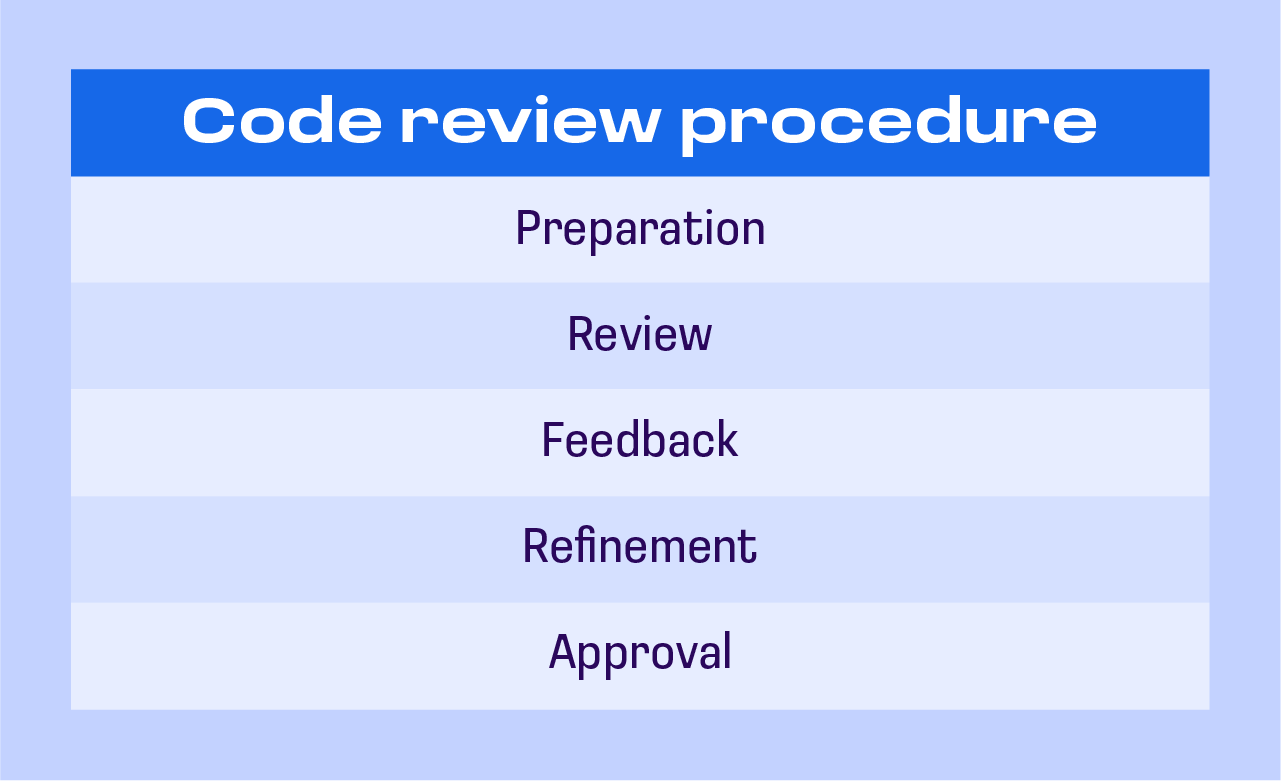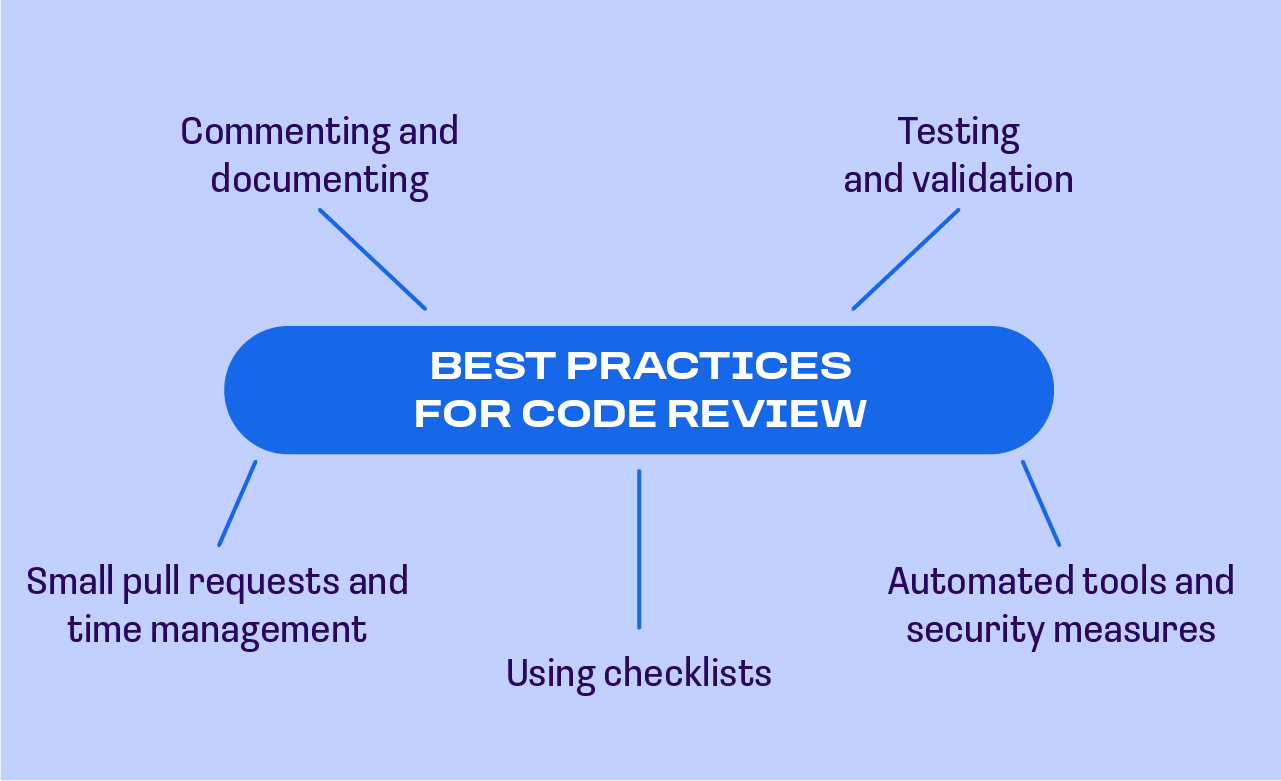Code review process: how to do and improve it
The author of this article is tech expert Pieter Murphy. Invited expert — Vitali Vishneuski, Delivery Manager, EngX Expert.

Software developers who intend to produce clean and maintainable code dedicate time to reading and reviewing it, as well as undergoing peer-based code review best practices. Code review is a crucial phase of development, and in this article, I explore what it involves to understand it.
Code review is a systematic examination of software code that developers perform to mitigate the occurrence of bugs, improve quality, and be compliant with best practices. The source code can be analyzed using an automated review tool or manually by a team. It is a fundamental practice in software development.
Let’s now discuss how to do a code review, why it’s important, some real-life best practices, and how to improve the entire process.
Code review process overview
Effective code reviews ensure that every project is of high quality and that software engineering teams adhere to development best practices.
The process typically focuses on aspects such as correctness, maintainability, readability, performance, and consistency.
It is an opportunity for developers to share knowledge, continuously improve (especially in DevOps frameworks), ensure codebase consistency, reduce test cycles, prepare documentation, and build confidence in the final product.
Why is the code review process important?
Reviewing a code is crucial in maintaining and improving software quality. Here are some of the reasons why it is indispensable:
Improving team performance
The code review process is especially beneficial for newer developers, helping them identify areas for improvement in code optimization. Junior developers often lack the experience to know specific optimization techniques, and reviews provide them with valuable feedback from senior developers. This guidance helps them enhance their coding skills and avoid critical errors that could lead to bugs.
Even experienced developers can overlook mistakes due to the monotonous nature of programming. Code reviews introduce fresh eyes to examine each unit of code, catching errors before the code advances to the next stage. The reviewer conducts thorough checks and points out mistakes for the author to rectify.
Code reviews not only enhance individual coding skills and catch errors early but also play a crucial role in speeding up further development. By ensuring that code is clean, optimized, and free of critical mistakes from the outset, the review process minimizes the time spent on debugging and rework in later stages. This proactive approach allows development teams to maintain a smooth flow, focusing their efforts on building new features and refining existing ones rather than constantly firefighting issues.
Ensuring consistency and collaboration
Large projects often involve multiple developers, each with their unique coding style. However, adhering to individual styles can hinder collaboration and stall overall progress. The process of reviewing a code encourages developers to follow standardized coding practices, ensuring consistency throughout the development phase. This standardization makes the source code easier for both new and experienced developers to understand and work with.
Consistent coding patterns are particularly valuable in the long run as team members continue to make changes to the project. This consistency allows future developers to spend less time analyzing existing code and more time building new features for a website or application.
The reviews also foster peer-to-peer collaboration among developers. Programmers often work in isolation, but the code review procedure encourages interaction, allowing developers to exchange thoughts and ideas. This process builds mutual trust among team members and keeps everyone updated on the latest technologies and developments.
Enhancing code maintainability
Reviewing a code enhances code maintainability by informing other developers about the code's logic and function. This makes it easier to maintain the code even when the original author is unavailable.
Monitoring project requirements
Every project has a scope and requirements, which often evolve during development. Each team is responsible for monitoring these changes and responding appropriately. The reviews help keep project objectives in focus and address any tricky situations that may arise.
I asked Vitali Vishneuski, Delivery Manager, EngX Expert, what the consequences of poor code review are. He responded that poor review of code results in “bad quality of code which might lead to significant effort for maintenance and further development of solution.”
I have a code review checklist to help you understand what it looks like and what to expect when working in environments that use it.
How to perform a code review? Step-by-step guide
A well-structured code review process is essential for maintaining high-quality code and fostering a collaborative development environment. This guide will walk you through the steps, purpose, and best practices for conducting an effective review of a code, as well as how to improve it.
Preparation
Before submitting code for review, the author must set up a thorough initial check to ensure it compiles and runs without errors. The code should pass all tests to confirm it functions as expected. Additionally, the author should provide a detailed description of what the code is meant to do, why the changes were necessary, and any relevant context. Highlighting specific areas where potential issues might exist or where feedback is needed helps reviewers understand the purpose and scope of the changes.
Key actions:
- Ensure code compiles and runs without errors.
- Pass all tests to confirm functionality.
- Provide a detailed description and context.
- Highlight potential issues or areas needing feedback.
Review
Reviewers should take the time to read through the code to understand its functionality and purpose. This involves running the code or examining related parts of the codebase. They should check for logical inconsistencies, potential bugs, and adherence to coding standards and best practices. The review should also evaluate the code's efficiency and performance.
Key actions:
- Understand the code's functionality and purpose.
- Check for logical inconsistencies and potential bugs.
- Ensure adherence to coding standards and best practices.
- Evaluate code efficiency and performance.
Feedback
Providing clear and specific feedback is crucial. Reviewers should identify what is wrong, where it is located, and why it is a problem. Suggestions for improvements, including alternative approaches, optimizations, or better practices, should be provided. Balancing criticism with praise helps maintain a positive tone and encourages good practices. Constructive criticism should be given professionally and respectfully to foster a supportive and collaborative environment.
Key actions:
- Provide clear and specific feedback.
- Suggest improvements and best practices.
- Balance criticism with praise.
- Maintain a professional and respectful tone.
Refinement
After receiving feedback, the author should make the necessary changes. If any suggestions are not followed, explanations for such decisions should be provided. All changes should pass the tests and meet the standard. The author should clearly communicate what changes were made in response to the feedback.
Key actions:
- Implement necessary changes based on feedback.
- Provide explanations for any unimplemented suggestions.
- Ensure all changes pass tests and meet standards.
- Communicate changes clearly.
Approval
After addressing the feedback, reviewers perform a final check to ensure all issues have been resolved and the code is ready for integration. Once everything is satisfactory, the reviewers approve the code, and it is merged into the main branch, concluding the code review process.
Key actions:
- Perform a final check of the code.
- Ensure all issues have been resolved.
- Approve and merge the code into the main branch.
So, what are the most important stages of code review? While it follows several different steps, they’re all equally important for the process. In fact according to expert Vitali V. “There is a single stage. It is a Code Review.”
Lastly, what are the most common mistakes in reviewing a code? The most common mistake in is “ When code review itself is replaced by code read,” says Vitali Vishneuski. Others may include overlooking testing, personal bias and attitude, and rushing the review process.

Best practices for code review
The review process is essential for maintaining high-quality, secure code within any development team, enabling a streamlined flow through the phases of software development. However, it can be challenging to organize and execute effectively. By following best practices for reviewing a code to enhance the process, teams can streamline this process and achieve better outcomes.
Commenting and documenting
Adding non-functional comments in sections of the code to explain the intent of the code block is a good practice for developers. These comments clarify the reasons for certain decisions and ensure readability for the entire team. While internal conversations like video calls or face-to-face exchanges are important, it is essential to document these discussions. Tracking and recording the review outcomes through traceable tools, such as code review tools, ensures that decisions are well-documented for future reference.
Testing and validation
Using automated test suites to write unit tests for every block of code is an effective approach to validating specific procedures. The test suite evaluates a known function against a known positive result, and any failures can pinpoint areas that need modification. Additionally, testing the output and functionality of new code sections can significantly reduce review time later on. It is easier to correct a small part of the code when the rest of it functions properly, thus ensuring that the code quality review process is efficient.
Small pull requests and time management
Developers should create small PRs with clear instructions for reviewers to increase the speed and efficiency of the manual code quality review process. Ideally, a PR should be less than 250 lines to allow reviewers to discover 70-90% of defects in less than an hour. Code review can be tedious and time-consuming. It is essential to set time limits for how long a team or reviewer spends on each line of code. For instance, a team might decide to spend no more than an hour on code review or limit the review to several hundred lines of code within a specified timeframe.
Automated tools and security measures
Before manual reviews, developers can use tools like automated code checkers, scanners, or code analyzers to check the quality of the codebase after making changes. These tools can catch overt formatting mistakes, allowing the review team to focus on interpretive or stylistic errors. Security breaches can cause serious problems for organizations. The software engineer and other team members must understand the code’s vulnerabilities and the security issues that need handling. Setting up measures to overcome these vulnerabilities is essential for maintaining secure code.
Using checklists
Checklists are an effective way to eliminate frequent errors and address omissions. A checklist for reviewing a code provides team members with clear objectives for each review and helps in process improvement and reporting purposes.

Check out these code review best practices for software engineers to get you started:
How to make the code review process even more effective?
There are strategies that you can be implementing to make the code review processes more effective.
First there needs to be clear objectives within the team such as improving code readability and maintainability, identifying and fixing bugs, enhancing performance and security, and ensuring compliance.
For a code review to be effective, it cannot be treated as an afterthought or something to be done in between other tasks. Ensure that the team allocate time for reviews to ensure that they are thoughtful and thorough.
Foster and encourage a positive, collaborative review culture through encouraging open communication and discussion, celebrating good practices and improvements, and promoting respectful and constructive feedback.
Continuous improvement is necessary, too. Regularly revisit and refine the review practices by getting feedback from the team about what’s working and what needs improving. Stay updated with the latest tools and techniques to enhance the process.
There are several ways of making the code review development process more efficient as well as improving and optimizing it. Vitali V. recommends discussing and continuously updating Code Conventions and Standards with the team for particular projects.
By the way he also mentioned that Code Review can be enhanced or even replaced by Pair or Mob Programming practices. These collaborative techniques involve multiple developers working together on the same code, which can lead to real-time feedback, faster problem identification, and immediate resolution of issues.
How to improve code review process with courses from EngX?
EngX, or Engineering Excellence, is a dynamic initiative that originated in EPAM in 2014, aiming to boost the performance of software engineers. Initially implemented within EPAM, EngX expanded its reach by offering a program to enhance software development performance for clients.
Recently, EngX ventured into the B&C market, making its decade-long technological advancements and industry insights available globally. A significant part of this expansion includes making its comprehensive courses accessible to anyone worldwide.
In recent years, EngX has dedicated extensive efforts to working with AI and optimizing engineering outcomes through the integration of artificial intelligence into its established framework.
If you want to learn how to review code, consider signing up for the EngX Code Review course from EngX. It is a course that experienced developers have curated. It is designed to benefit any developer irrespective of their level.
Through the EngX Code Review course, you’ll acquire more skills and knowledge in the following areas:
- Process essentials;
- Developing strategies;
- Best practices;
- Managing feedback;
- Choosing tools; and
- Common myths.
The best part about this course is that it is a great way to check and sharpen your skills in reviewing a code. You can complete a free 10-minute code review awareness survey to assess your proficiency relative to other learners, with highlights for areas you could improve.
So, for what level of specialists will this course be useful?
“For any level. Every software developer must review and be reviewed. Because it is not a question about their professionalism, but the topic of maintainability and extendability of solution,” answers Vitali Vishneuski, Delivery Manager, EngX Expert.
Consider checking out the guide on how to calculate code review effectiveness to find out how well implementing this process works for you.
Enjoy the EngX Clean Code course to write clean, maintainable code for faster development and reduced errors.


.png)
